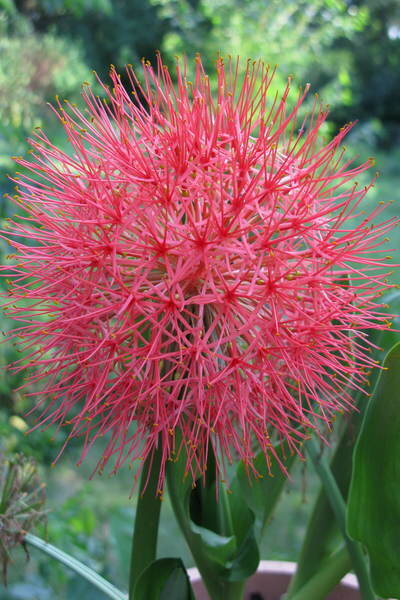Blood lily: a ball of fire in a flower pot
Loading...
For flashy, spherical, red blossoms indoors or out, the blood lily is a rare and unusual South African container plant.
With the latest predictions of temperatures dropping to the high 40s F. (4 to 9 C) at night in my area, it is time to start bringing in the tropical plants that I typically overwinter indoors.
The first to come in is the blood lily (Scadoxus multiflorus, formerly Haemanthus multiflorus) , also known as the powder-puff lily, African blood lily, fire-ball lily, and football lily. A dazzling, though somewhat bizarre-looking plant, there is, nevertheless, something special about it.
Yes, it is weird looking. And yes, it blooms for only two short weeks, or less. But when in full flower, it is an amazing conversation piece, stopping all friends and visitors dead in their tracks.
That alone is worth the price of the bulbs.
This blood lily is one of about 50 species of Scadoxus from central and southern Africa, but only a few are available in this country. It belongs to the Amaryllis family, and I treat it as such. Thus far, mine seem to be thriving.
Since they're hardy only to USDA Zone 8, I grow them in containers, where, when in full bloom, they drive visiting hummingbirds absolutely crazy – and the hummers' antics, in trying to figure out this curious plant, keep all on-lookers greatly entertained.
Spectacular flowers
Airy, alien looking, orange-red balls about the size of a small beach ball (up to 10 inches in diameter), consisting of numerous tiny flowers – up to 200, I’m told, but I haven’t actually counted them – each with miniscule yellow stamens) explode upon the scene in early summer on stout, solid, 1-foot stalks.
After bloom, rosettes of textured, glossy, dark green leaves arise atop speckled stalks, making it a fascinating and decorative foliage plant for months to come.
If pollinated, some stems produce small, round, bright orange-red fruits, which contain several seeds that, when planted fresh, can take up to six months to germinate. But thus far, no winged critter has taken it upon itself to pollinate my plants.
Cultural requirements
Here, in my Midwest garden, I grow my blood lilies in containers filled with a good commercial potting mix. However, the blood lily can be grown in the ground in frost-free climates if the conditions are similar to its tropical homeland.
That would mean: bulbs planted just below soil level, with excellent drainage; supplied with plenty of water while in active growth; kept hot and dry in dormancy; and best left undisturbed for many years. Although tolerant of full sun, in the wild blood lilies are often found growing in the shade of small shrubs.
But for most of us, it’s best to grow them in pots. Plant the bulbs with their necks just at or a little above soil level, taking care not to damage the fleshy roots. Fertilize once or twice during active growth with a weak feeding of liquid fertilizer.
My bulbs are only three years old, and this is the first year all five bulbs bloomed, though not all at once. (OK, maybe I’m being picky. But if they could only get their act together and bloom all at once, I’d highly appreciate it.) Literature tells me they should bloom in mid- to late summer, but mine bloom in early June.
Could it be that I have some teenager plants on my hands?
Fall and winter care
After bloom, I let the blood lilies luxuriate in an out-of-the-way corner of the deck in partial shade until the weather forecasters predict temperatures dipping below 55 degrees F. (13 C). That's the wake-up call for me to start moving plants indoors.
Last year, I let the soil in the pots dry out and the bulbs go dormant. It took about a month for the foliage to completely dry out. I withheld water until spring, then started watering them once again, keeping them indoors until all danger of frost was gone.
This year, I’m toying with the idea of keeping the containers as houseplants, watering them all winter long just to see what happens come next spring.
A word of caution: The blood lily contains chemicals that are poisonous. Although it is considered to be “relatively low” in toxicity, the plant’s unusual blooms entice kids and pets like magnets. Therefore, I would keep a wary eye out when children and animals are present.
-----
Betty Earl, the Intrepid Gardener, is one of nine garden writers who blog regularly at Diggin' It. She's the author of “In Search of Great Plants: The Insider’s Guide to the Best Plants in the Midwest.” She also writes a regular column for Chicagoland Gardening Magazine and The Kankakee Journal and numerous articles for Small Gardens Magazine, American Nurseryman, Nature’s Garden, and Midwest Living Magazine, as well as other national magazines. She is a garden scout for Better Homes and Gardens and a regional representative for The Garden Conservancy. To read more by Betty, click here.






